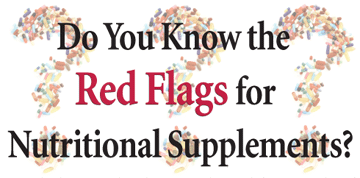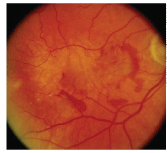

Americans spent $22 billion on nutritional supplements in 2006a fraction of the nearly $300 billion dollars spent on prescription and over-the-counter (OTC) pharmaceuticals.1 Today, more patients take a plethora of vitamins, minerals and herbs for systemic purposes. Optometrists should know and understand exactly how these nutraceuticals interact with conventional systemic pharmaceuticals.
So, we ask: Just how safe are these supplements, and what are the associated red flags, or potential complications?
Since primary care optometry requires an understanding of current treatment practices, both when it comes to ocular health and systemic health as it relates to the eyes, such nutraceuticals deserve our study and perhaps our concern. Furthermore, therapeutic treatment of chronic ocular disease may be a major element of both patient care and revenue for the eye care practice of the future.1,2
Patients are increasingly looking to use alternative or complementary methods of medication to facilitate the bodys natural healing response. Such patients want natural, effective, less expensive and less risky treatments when possible. Since the Food and Drug Administration (FDA) tends to approve drugs more quickly than before, many once-approved drugs, such as Vioxx (rofecoxib, Merck), have now been withdrawn based upon subsequent and more extensive safety testing. Could the same be true for supplements?
Some Common, Reversible Nutritional Supplement Side Effects: Diarrhea from increased vitamin C. Loose stools from magnesium. Finger tingling from vitamin B6. Discoloration of skin from beta-carotene.
Supplements in Practice
In many instances, dietary supplements produce the same biological effects as prescription and OTC drugs without associated side effects. Some examples of natural supplementation: Ginger instead of nonsteroidal anti-inflammatory drugs (NSAIDs) for inflammation; magnesium instead of calcium channel blockers to decrease inotropic cardiac contractibility and improve vascular peripheral resistance; fish oil instead blood thinners; garlic instead of aspirin for cardiovascular disease; and vitamin D instead of biphosphonates for osteoporosis.3-5 Indeed, eating 20 cherries reduces inflammation much like aspirin or cyclooxygenase-2 inhibiting drugs, without the harmful side effects of gastric bleeding or vitamin depletion. It is interesting to note that the molecules in cherries, anthocyanins, work to reduce inflammation at a dosage one-tenth that of aspirin.6
While most Americans have access to affordable, high-quality supplements, this is hardly the case in many third-world countries, according to Bruce Ames, Ph.D., a nutritional biochemist at the
Here is where optometry could play a vital public health role: Encourage your patients to not only use more nutritional supplements, but also consume increased amounts of fruits and vegetables and essential fatty acids, such as fish, nuts and flax seed.
Even healthy, aging populations require stronger nutritional supplementation for several reasons, such as malabsorption from gastric atrophic hypochlorhydria, vitamin B12 deficiency from frequent use of acid blockers, less efficient ubiquitin reprocessing and accumulated free radical attack and glycosylation.8 As we age, we experience more free-radical DNA damage with less efficient repair.
Also, our tissues become increasingly cross-linked and rigid due to carbonyl formation and glycosylation. So, the value of nutritional supplements for elderly individuals is becoming increasingly apparent.
Here are a few published studies concerning the safety of nutritional supplements and their potentially negative interactions with prescription and OTC pharmaceuticals.
Supplements vs. Drugs
A nutraceutical refers to a food (or part of a food) that provides medical or health benefits, including the prevention and/or treatment of a disease.1
Prescription drugs are approved through the rigorous New Drug Application (NDA) process of the FDA. Dietary supplements, on the other hand, are regulated as foods, and the FDA must determine if a dietary supplement ingredient poses a significant or unreasonable risk of illness or injury. Recently, however, research studies involving supplements must also undergo the same FDA Investigational New Drug (IND) application process.
Published statistical data widely suggests that the use of nutritional supplements alone does not yield serious systemic health consequences. However, when we look at the safety of either supplements or pharmaceuticals, we need to consider absolute numbers.
For example, taking one aspirin tablet each day may be as risky as being a firefighter. How can this be? Because 50-year-old men who take a daily aspirin (which reduces the chances for a heart attack by 30%), in absolute numbers, run the risk of dying from gastrointestinal bleeding by the equivalent of 10.4 deaths per 100,000 men per year. In comparison, professional firefighters face the risk of 10.6 deaths per 100,000 people per year, compared to 3.9 for all other occupations and 0.4 for office workers.9
The most complete and longstanding data on nutritional supplements comes from the American Association of Poison Control Centers, which reviewed the cumulative effect of 29,000 supplement products from more than 600 manufacturers.10 Over a 23-year period, there were 230 deaths, approximately 10 per year, caused by supplements in the
In February 2007, the Journal of the American Medical Association printed a pooled analysis of 68 published studies, which suggested that the American mortality rate was insignificantly affected by antioxidant supplementation of vitamins A, C, E, beta-carotene and selenium.13 Yet, media headlines said otherwise, noting that a subset of 47 better-quality studies showed there were 15,366 deaths among 81,343 subjects who took antioxidants (15.5%) vs. 9,131 deaths among 81,343 subjects who did not take antioxidants (11.2%), for a difference of 4.2% in absolute numbersnot the relative 15.5% figure used by the media.
Additionally, there are numerous problems with meta-analyses besides the use of relative numbers and selective inclusion, such as the possibility that older and sicker people could, for example, take more dietary supplements.
In the Heart Outcomes Prevention Evaluation (HOPE) Study, 19 studies of 135,000 total people reported that 400IU of vitamin E per day increased the relative risk of dying by 4%.14 Again, the media sensationalized the story.
What researchers claimed was that high doses of vitamin E increased the risk of heart failure by an absolute 1% risk among people who take three drugs that have the potential to induce heart failure (diuretics, statins and beta blockers). Ultimately, vitamin E was blamed for the problem. Worse yet, the researchers eliminated studies where there were no reported deaths, in addition to two other studies that showed a decreased risk!
Potentially Adverse Reactions
In 2005, Hanna Bartlett, Ph.D., and Frank Eperjesi, Ph.D., reviewed more serious contraindications and adverse reactions associated with the use of ocular nutritional supplements.15 They concluded that vitamin A supplements and Acutane (isotretinoin, Roche Laboratories), a vitamin A derivative, should be avoided in women who may become pregnant, and men and women who have liver disease or drink heavily.
Relationships have also been found between vitamin A and reduced bone mineral density. But, this is most likely related to concurrent ubiquitous vitamin D deficiency, since vitamins A and D as fat-soluble vitamins compete for storage allocation in the liver.16
So, most multivitamin manufacturers have either reduced the amount of vitamin A in their products or have provided vitamin A in the form of beta-carotene, which converts to vitamin A on an as-needed basis. This systemic process prevents an overdose.
In both the Beta-Carotene and Retinol Efficacy Trial (CARET) and the Alpha-Tocopherol, Beta-Carotene Cancer Prevention Trial (ATBC), a relationship was found between beta-carotene and an increased risk for lung cancer in males who smoke.17,18 This may be related to unbalanced carotenoid intake.
Glucosamine, used by patients with osteoarthritis, has been reported to trigger a rise in blood sugar among healthy adults; yet, two separate studies could not reproduce this effect.19,20
Although ginkgo biloba has anticoagulant and anti-platelet effects, high doses have not been found to be problematic in carefully controlled studies.21,22
That said, one should nonetheless have a working knowledge of blood thinning nutrients and pharmaceuticals which, in combination, may pose a risk of bleeding in the body, i.e. hemorrhagic stroke.
The common blood thinning agents encountered in optometric practice include:
Coumadin (warfarin sodium, Bristol-Meyers Squibb) and heparin.
ASA (aspirin, Bayer), especially full-dose non-enteric coated.
Vitamin E above 1100IU.
Fish oil above 2 grams.
Ginkgo biloba and ginseng.
Drug/Nutrient Interactions

Patients with age-related macular degeneration may experience reduced CoQ10 levels from taking high dosages of statins and/or beta blockers. CoQ10 supplements can reverse this deficiency and may help prevent additional oxidation.
Courtesy: Christopher Lievens, O.D.
One of the least considered issues in medicine is the interaction of pharmaceuticals with nutrients. This is something that deserves our attention because the problems are increasing. By age 65, the average American takes four prescription medications.
There were 700,000 emergency room visits for overdoses and allergic reactions in 2005. In the same year, more than 15,000 people died from drug reactions compared with 5,519 people in 1998.23 Many of these were fatalities linked to generic pain pills, such as oxycodone, fentanyl, morphine and acetaminophen.
In 2005, there were 89,482 serious side effects reported to the FDA2.5 times the number reported in 1998.10,23
More than half of all approved drugs, such as Vioxx and Baycol (cerivastatin, Bayer AG), produce serious side effects not detected prior to FDA approval.24 Only 3% of prescription medicines have been withdrawn from the American market for safety reasons over the last 20 years.
We now realize that many of these side effects and deaths could have been avoided by compensating for drug-induced nutrient depletion through the use of simple comprehensive multivitamins, minerals and individual nutrients.
Here are a few examples:
Chronic use of proton pump inhibitors for dyspepsia and gastroesophageal reflex disease (GERD) can induce vitamin B12 deficiency, which may cause
secondary effects on optic nerve function.25
Chronic or high dose
acetaminophen use may induce
glutathione deficiency, which accelerates cataract formation and yields myriad effects on ocular tissues.26
Overuse of steroids, such as dexamethasone and prednisolone, can induce deficiencies of vitamins C and D, folic acid, zinc, potassium, magnesium and selenium.27
One of the most important emerging optometric issues is coenzyme Q10 (CoQ10) depletion in patients taking high dosages of statins and/or beta blockers, which I have found can worsen age-related macular degeneration. This may be the very reason why the statin drug-AMD studies to date have been equivocal, or, at best, demonstrate a small positive or negative effect. On one hand, statins improve lipid profiles and reduce arteriolar inflammation. On the other hand, they can, especially in high dose situations, deplete CoQ10 levels in the photoreceptor outer segments.28
CoQ10 depletion is of further particular concern for AMD patients with concurrent neurodegenerative diseases, such as Parkinsons Disease, which are associated with further loss of mitochondrial CoQ10 reserves.29 Aging alone diminishes CoQ10 reserves in all tissues, so chronic use of beta-blocker eye drops by a patient who is already taking oral cardiovascular drugs that may deplete coenzyme Q10 (e.g., statins, oral beta blockers, thiazide diuretics, metformin and glyburide) should be carefully monitored.
Always look for red flags, but do not avoid your responsibility to inform patients of the benefits of nutritional supplementation with respect to aging, disease and drug-induced nutrient depletion. Staying current in the field of ocular nutrition and carefully reading studies, not just media headlines, serves several purposes.
First, you will help to solve the patients main problem. Second, you will enhance your understanding of the patients overall health. Also, you will bring patients back to your office. Finally, the information provided by you is more reliable than the buzz from the health-food store clerk.
Dr. Richer is chief of optometry at the Department of Veterans Affairs Medical Center and an associate professor of family and preventative medicine at Rosalind Franklin University of Medicine and Science in
1. Everitt AV, Hilmer SN, Brand-Miller JC, et al. Dietary approaches that delay age-related diseases. Clin Interv Aging 2006;1(1):11-31.
2. Timmons J. Interview by author, 15 May 2005.
3. Sardi B. Knowledge of Health. Available at: www.knowledgeofhealth.com (Accessed January 15, 2008).
4. Whittaker J. Your Definite Guide to Wellness Medicine. Available at: www.JulianWhitaker.com (Accessed January 15, 2008).
5. Mercola J. Natural Health Information Articles. Available at: www.mercola.com (Accessed January 15, 2008).
6. Kelley DS, Rasooly R, Jacob RA, et al. Consumption of Bing sweet cherries lowers circulating concentrations of inflammation markers in healthy men and women. J Nutr 2006 Apr;136(4):981-6.
7. Ames BN. Increasing longevity by tuning up metabolism. To maximize human health and lifespan, scientists must abandon outdated models of micronutrients. EMBO Rep 2005 Jul;6 Spec No:S20-4.
8.
9. Cohen JT, Neumann PJ. What"s more dangerous, your aspirin or your car? Thinking rationally about drug risks (and benefits). Health Aff (Millwood) 2007 May-Jun;26(3):636-46.
10. Watson WA, Litovitz TL, Klein-Schwartz W, et al. 2003 annual report of the American Association of Poison Control Centers Toxic Exposure Surveillance System. Am J Emerg Med 2004 Sep;22(5):335-404.
11. Litovitz TL, Klein-Schwartz W, Rodgers GC Jr., et al. 2001 annual report of the American Association of Poison Control Centers Toxic Exposure Surveillance System. Am J Emerg Med 2002 Sep;20(5):391-452.
12. Meyers DG, Maloley PA, Weeks D. Safety of antioxidant vitamins. Arch Intern Med 1996 May 13;156(9):925-35.
13. Bjelakovic G, Nikolova D, Gluud LL, et al. Mortality in randomized trials of antioxidant supplements for primary and secondary prevention: systematic review and meta-analysis. JAMA 2007 Feb 28;297(8):842-57.
14. Lonn E, Bosch J, Yusuf S, et al. Effects of long-term vitamin E supplementation on cardiovascular events and cancer: a randomized controlled trial. JAMA 2005 Mar 16;293(11):1338-47.
15. Bartlett H, Eperjesi F. Possible contraindications and adverse reactions associated with the use of ocular nutritional supplements. Ophthal Physiol Opt 2005 May;25(3):179-94.
16.
17. The Alpha-Tocopherol, Beta Carotene Cancer Prevention Study Group. The effect of vitamin E and beta carotene on the incidence of lung cancer and other cancers in male smokers.
18. Omenn GS, Goodman G, Thornquist M, et al. Effects of a combination of beta carotene and vitamin A on lung cancer and cardiovascular disease. N Engl J Med 1996 May 2;334(18):1150-5.
19. Tannis AJ, Barban J, Conquer JA. Effect of glucosamine supplementation on fasting and non-fasting plasma glucose and serum insulin concentrations in healthy individuals. Osteoarthritis Cartilage 2004 Jun;12(6):506-11.
20. Scroggie DA, Albright A, Harris MD. The effect of glucosamine-chondroitin supplementation on glycosylated hemoglobin levels in patients with type 2 diabetes mellitus: a placebo-controlled, double-blinded, randomized clinical trial. Arch Intern Med 2003 Jul 14;163(13):1587-90.
21. Koch E. Inhibition of platelet activating factor (PAF)-induced aggregation of human thrombocytes by ginkgolides: considerations on possible bleeding complications after oral intake of Ginkgo biloba extracts. Phytomedicine 2005 Jan;12(1-2):10-6.
22. Koehler S, Funk P, Kieser M. Influence of a 7-day treatment with ginkgo biloba special extract EGb 761 on bleeding time and coagulation: a randomized, placebo-controlled, double-blind study in healthy volunteers. Blood Coagul Fibrinolysis 2004 Jun;15(4):303-9.
23.
24.
25. Valuck RJ, Ruscin JM. A case-control study on adverse effects: H2 blocker or proton pump inhibitor use and risk of vitamin B12 deficiency in older adults. J Clin Epidemiol 2004 Apr;57(4):422-8.
26. Amar PJ, Schiff ER. Acetaminophen safety and hepatotoxicitywhere do we go from here? Expert Opin Drug Saf 2007 Jul;6(4):341-55.
27. Pelton R, Lavalle JB, Hawkins EB, et al. Drug-Induced Nutrient Depletion Handbook, 2nd Edition.
28. Blasi MA, Bovina C, Carella G, et al. Does coenzyme Q10 play a role in opposing oxidative stress in patients with age-related macular degeneration? Ophthalmologica 2001 Jan-Feb;215(1):51-4.
29. Lenaz G, Baracca A, Fato R, et al. Mitochondrial Complex I: structure, function, and implications in neurodegeneration. Ital J Biochem 2006 Sep-Dec;55(3-4):232-53.

